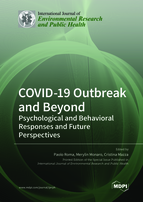COVID-19 Outbreak and Beyond: Psychological and Behavioral Responses and Future Perspectives
A special issue of International Journal of Environmental Research and Public Health (ISSN 1660-4601).
Deadline for manuscript submissions: closed (31 October 2021) | Viewed by 121290
Special Issue Editors
Interests: personality and individual differences; testing and assessment; clinical psychology; malingering
Interests: forensic psychology; human computer interaction; mouse tracking; machine learning
Interests: clinical psychology; forensic psychology; psychotherapy; personality and individual differences; testing and assessment
Special Issue Information
Dear Colleagues,
The COVID-19 pandemic drastically changed our lifestyle when, on 30 January 2020, the World Health Organization declared the coronavirus disease outbreak a public health emergency of international concern. Since then, many governments have introduced unprecedented containment measures, hoping to slow the spread of the virus. International researches suggest that both the pandemic and the related protective measures, such as lockdown, curfews, and social distancing, are having a profound impact on the mental health of the population. Among the most commonly observed psychological effects, there are high levels of stress, anxiety, depression, and post-traumatic symptoms, along with boredom and frustration. At the same time, the behavioral response of the population is of paramount importance to successfully contain the outbreak, creating a vicious circle in which the psychological distress impacts the willingness to comply with the protective measures, which in turn, if prolonged, could exacerbate the population’s distress. For this Special Issue, we welcome original studies on the worldwide psychological and behavioral impact of COVID-19 on targeted individuals (e.g., parents, social workers, patients affected by physical and mental disorders). Moreover, studies exploring the effect of COVID-19 using advanced statistical and methodological techniques (e.g., machine learning technologies) will be prioritized. Finally, researches with a focus on practical applications that could help identify persons at risk, mitigate the negative effects of this situation, and offer insights to policymakers to manage the pandemic are also highly welcomed.
Prof. Dr. Paolo Roma
Dr. Merylin Monaro
Dr. Cristina Mazza
Guest Editors
Manuscript Submission Information
Manuscripts should be submitted online at www.mdpi.com by registering and logging in to this website. Once you are registered, click here to go to the submission form. Manuscripts can be submitted until the deadline. All submissions that pass pre-check are peer-reviewed. Accepted papers will be published continuously in the journal (as soon as accepted) and will be listed together on the special issue website. Research articles, review articles as well as short communications are invited. For planned papers, a title and short abstract (about 100 words) can be sent to the Editorial Office for announcement on this website.
Submitted manuscripts should not have been published previously, nor be under consideration for publication elsewhere (except conference proceedings papers). All manuscripts are thoroughly refereed through a single-blind peer-review process. A guide for authors and other relevant information for submission of manuscripts is available on the Instructions for Authors page. International Journal of Environmental Research and Public Health is an international peer-reviewed open access monthly journal published by MDPI.
Please visit the Instructions for Authors page before submitting a manuscript. The Article Processing Charge (APC) for publication in this open access journal is 2500 CHF (Swiss Francs). Submitted papers should be well formatted and use good English. Authors may use MDPI's English editing service prior to publication or during author revisions.
Keywords
- COVID-19
- psychological distress
- compliance
- behavioral response
- advanced techniques
- health impairments








